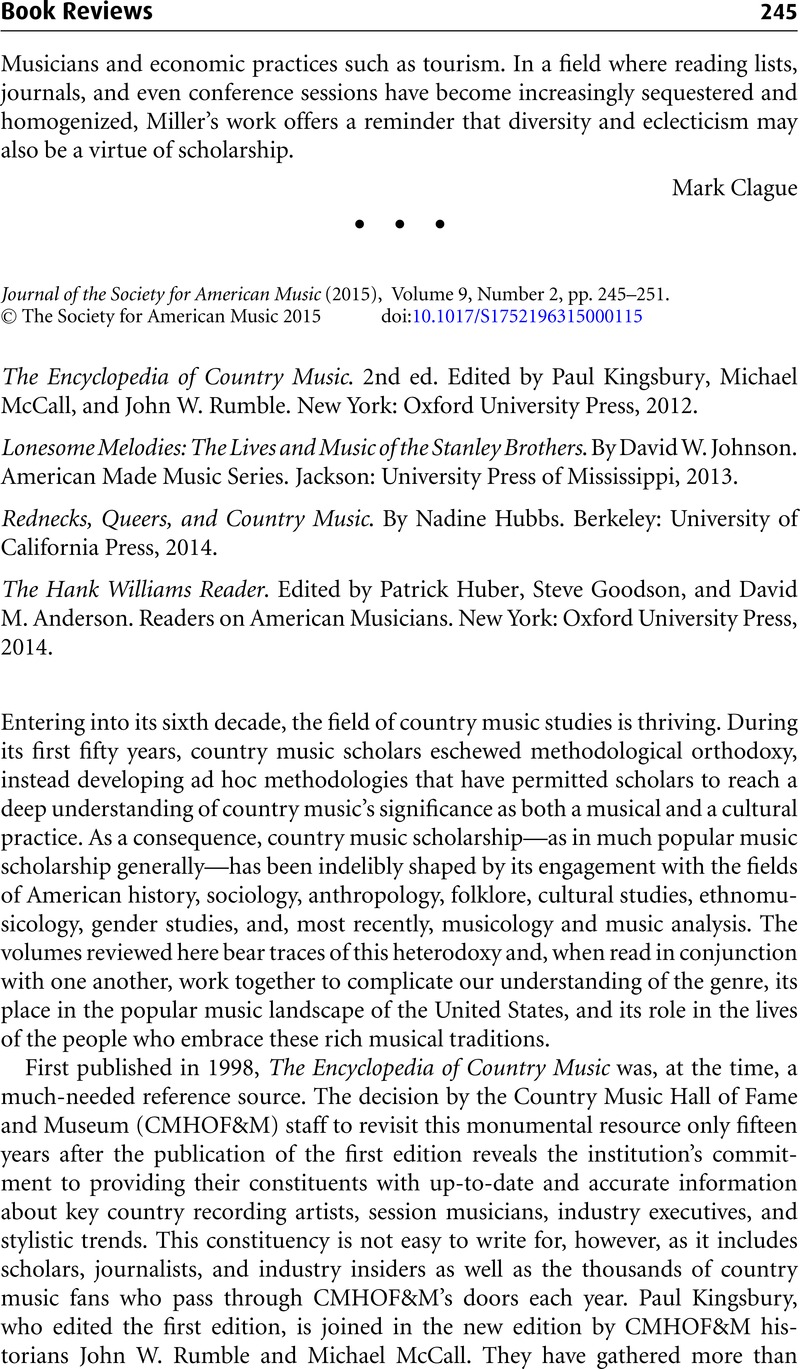No CrossRef data available.
Article contents
The Encyclopedia of Country Music. 2nd ed. Edited by Paul Kingsbury, Michael McCall, and John W. Rumble. New York: Oxford University Press, 2012. - Lonesome Melodies: The Lives and Music of the Stanley Brothers. By David W. Johnson. American Made Music Series. Jackson: University Press of Mississippi, 2013. - Rednecks, Queers, and Country Music. By Nadine Hubbs. Berkeley: University of California Press, 2014. - The Hank Williams Reader. Edited by Patrick Huber, Steve Goodson, and David M. Anderson. Readers on American Musicians. New York: Oxford University Press, 2014.
Published online by Cambridge University Press: 11 May 2015
Abstract

- Type
- Book Review
- Information
- Copyright
- Copyright © The Society for American Music 2015
References
1 Pecknold, Diane, The Selling Sound: The Rise of the Country Music Industry (Durham: Duke University Press, 2007), 189–99CrossRefGoogle Scholar.
2 See, for instance, Abramson, Bram Dev, “Country Music and Cultural Industry: Mediating Structures in Transnational Media Flow,” Media, Culture & Society 24/2 (2002): 255–74CrossRefGoogle Scholar; Baker, Sarah and Huber, Alison, “Locating the Canon in Tamworth: Historical Narratives, Cultural Memory and Australia's ‘Country Music Capital,’” Popular Music 32/2 (2013): 223–41CrossRefGoogle Scholar; Cohen, Sara, “Country at the Heart of the City: Music, Heritage, and Regeneration in Liverpool,” Ethnomusicology 49/1 (Winter 2005): 25–48CrossRefGoogle Scholar; Dent, Alexander Sebastian, “Cross-Cultural ‘Countries’: Covers, Conjuncture, and the Whiff of Nostalgia in Música Sertaneja (Brazilian Commercial Country Music),” Popular Music and Society 28/2 (May 2005): 207–27CrossRefGoogle Scholar; Dueck, Byron, Musical Intimacies & Indigenous Imaginaries: Aboriginal Music and Dance in Public Performance (New York: Oxford University Press, 2013)CrossRefGoogle Scholar.
3 Bufwack, Mary A. and Oermann, Robert K., Finding Her Voice: Women in Country Music, 1800–2000 (Nashville, TN: Vanderbilt University Press and Country Music Foundation Press, 2003)Google Scholar.
4 Particularly noteworthy in this regard is Pecknold, Diane, ed., Hidden in the Mix: The African American Presence in Country Music (Durham, NC: Duke University Press, 2013)CrossRefGoogle Scholar.
5 Williams, Roger M., Sing a Sad Song: The Life of Hank Williams (New York: Doubleday, 1970; 2nd ed., Urbana: University of Illinois Press, 1981)Google Scholar; Leppert, Richard and Lipsitz, George, “‘Everybody's Lonesome for Somebody’: Age, the Body and Experience in the Music of Hank Williams,” Popular Music 9/3 (October 1990): 259–74CrossRefGoogle Scholar.
6 Godbey, Marty, Crowe on the Banjo: The Music Life of J. D. Crowe (Urbana: University of Illinois Press, 2011)Google Scholar; Graves, Josh, Bluegrass Bluesman: A Memoir, ed. Bartenstein, Fred (Urbana: University of Illinois Press, 2012)Google Scholar.
7 Ralph Stanley, the younger of the Stanley Brothers, was the subject of John Wright's outstanding 1995 oral history project, Traveling the High Way Home: Ralph Stanley and the World of Traditional Bluegrass Music (Urbana: University of Illinois Press, 1995). In 2009, Stanley published his memoir, co-written with journalist Dean, Eddie: Man of Constant Sorrow: My Life and Times (New York: Gotham Books, 2009)Google Scholar.
8 Rockwell, Joti, “Time on the Crooked Road: Isochrony, Meter, and Disruption in Old-Time Country and Bluegrass Music,” Ethnomusicology 55/1 (Winter 2011): 55–57CrossRefGoogle Scholar.
9 This outmigration has been the subject of much scholarly and popular writing, most notably in Berry, Chad, Southern Migrants, Northern Exiles (Urbana: University of Illinois Press, 2000)Google Scholar; Gregory, James N., The Southern Diaspora: How the Great Migrations of Black and White Southerners Transformed America (Chapel Hill: University of North Carolina Press, 2005)Google Scholar; Feather, Carl E., Mountain People in a Flat Land: A Popular History of Appalachian Migration to Northeast Ohio, 1940–1965 (Athens: Ohio University Press, 1998)Google Scholar; and Obermiller, Phillip J., Wagner, Thomas E., and Tucker, E. Bruce, eds., Appalachian Odyssey: Historical Perspectives on the Great Migration (Westport, CT: Praeger, 2000)Google Scholar. Bluegrass historian Neil V. Rosenberg has also explored the connections between bluegrass and the Appalachian diaspora in Bluegrass: A History (Urbana: University of Illinois Press, 1985), 9, 119–20.
10 Peterson, Richard A. and DiMaggio, Paul, “From Region to Class, The Changing Locus of Country Music: A Test of the Massification Hypothesis,” Social Forces 53/3 (March 1975): 497–506CrossRefGoogle Scholar; Ching, Barbara, Wrong's What I Do Best: Hard Country Music and Contemporary Culture (New York: Oxford University Press, 2001)Google Scholar; Fox, Aaron A., “White Trash Alchemies of the Abject Sublime: Country as ‘Bad’ Music,” in Bad Music: The Music We Love to Hate, eds. Washburne, Christopher J. and Derno, Maiken (New York: Routledge, 2004), 39–61Google Scholar; Fox, Aaron A., Real Country: Music and Language in Working-Class Culture (Durham, NC: Duke University Press, 2004)CrossRefGoogle Scholar; Fox, Pamela, Natural Acts: Gender, Race, and Rusticity in Country Music (Ann Arbor: University of Michigan Press, 2009)CrossRefGoogle Scholar.




